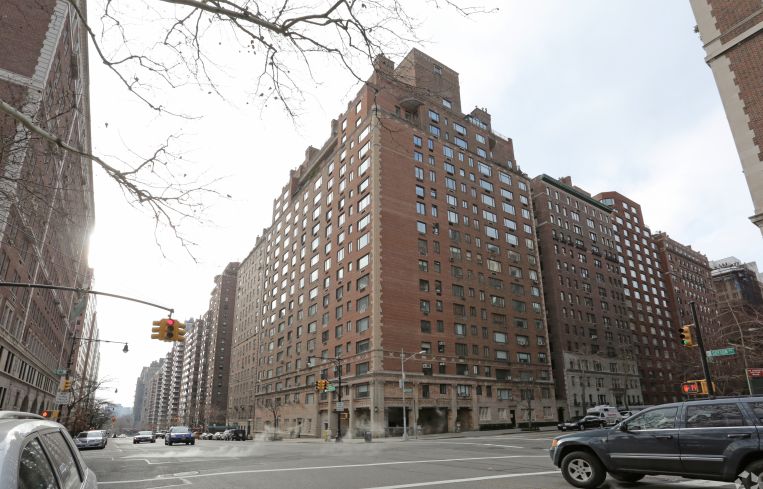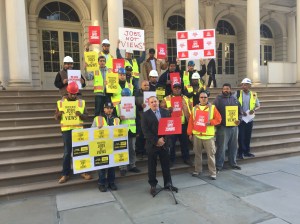City Planning Holds First Hearing On Fate of Gamma Real Estate’s Sutton Place Development
By Mack Burke October 19, 2017 11:00 am
reprints
The New York City Planning Commission yesterday held its hearing on a revised rezoning proposal that aims to limit the scope of Gamma Real Estate’s planned project at 3 Sutton Place.
On October 2, the city certified the new proposal, which would allow Gamma to move forward with construction on its planned 67-story, 800-foot-tall residential tower now called Sutton 58—located at 430 East 58th Street between First Avenue and Sutton Place—without the need for an affordable housing component or height cap.
The proposal was brought forth by the East River Fifties Alliance (ERFA) and would force Gamma—and any new development in Community District 6, from east of First Avenue and north of East 51st Street, that’s allocated more than 25 percent of its total floor area to residential uses—to follow “tower-on-a-base” requirements, which mandates that 45 to 50 percent of the building must be built below 150 feet. The initial rezoning proposal the coalition introduced last June called for a 260-foot height restriction and the inclusion of a significant portion of the tower to affordable housing.
“In their previous proposal, they alleged an affordable housing element. They ended up taking that part out,” Gamma Principal Jonathan Kalikow told CO. “This new proposal really shows their true colors.”

Prior to the hearing, Kalikow organized and led a small rally in front of City Hall and marched to the location of the Department of City Planning’s hearing room at 22 Reade Street with labor activists and roughly 20 construction workers carrying signs with messages such as “Preserve Jobs, Not Views,” “No ERFA Backroom Deal” and “Stop Spot Zoning.”
“At the end of the day, people understand this is not the New York City way,” Kalikow told CO while he and his group of supporters were en route to the hearing. “We had a viable process. The fact that we were railroaded, you know, no citizen should want to see that.”
The ERFA wrote in its revised proposal that “the combination of these [new] rules would more closely align future construction with the existing built environment, while still accommodating reasonable growth.” The community coalition consists of 45 area buildings and roughly 2,600 individual supporters who live in approximately 500 buildings in and outside the proposed area of rezoning; it was formed in 2016, shortly after the first announcements of the development, to oppose and combat the construction of Sutton 58.
Mayor Bill de Blasio’s administration has championed the expansion of affordable housing throughout all five boroughs, but he, as well as the City Planning Commission, opposed the ERFA’s original rezoning proposal, which was backed by several community representatives, including Manhattan Borough President Gale Brewer and Councilman Ben Kallos, who represents the residents of Sutton Place. New York State Senator Liz Krueger has backed the proposal, and recently, New York Congresswoman Carolyn Maloney signed on in support of the ERFA’s mission, having already written and voiced concerns to the CPC on the organization’s behalf, according to an ERFA spokeswoman.
Opponents of the ERFA’s new proposal who testified at the hearing included construction workers from the two companies tapped to build the property—Lendlease, to oversee the project, and Urban, for the building’s foundation—charged with building the project, representatives of New York’s real estate industry, Gamma’s legal counsel and even some residents of the Sutton Place area, who claimed that the bill simply doesn’t benefit the public and only sets a bad precedent for rezoning efforts going forward. They argued that the plan is an effort to spot zone this one property, that it goes directly against de Blasio’s plan to expand affordable housing throughout the five boroughs and that it will also take work away from construction companies as well as inhibit the growth of neighborhood economies.
“The Mayor was very clear about it when he attended a town hall on the Upper East Side a couple weeks ago: [this proposal] would provide an opportunity for people who have the means to mount a challenge to try this method of spot zoning to go forward… it becomes a tool for people to use against any undesirable development,” Real Estate Board of New York President John Banks told CO. “We’re concerned that there is no comprehensive planning that would take place if this becomes more of a norm.”
Members of the ERFA and Kallos said that their efforts don’t constitute an attempt to spot-zone the property and that their rezoning application addresses the entire zoning area. The ERFA, backed by Kallos, wants to take its fight city-wide to stop super tall residential skyscrapers.
The proposal’s supporters at the hearing included elected officials and spokespeople for elected officials, ERFA representatives and residents of Sutton Place. They argued that the community is the victim of what Kallos called an “accident of history” in his official testimony, meaning the nine-block area is the only residential area of the city zoned R10 without a tower-on-a-base standard or any type of contextual protection.
“The Sutton area is uniquely vulnerable to the development of super tall towers, a building form that was neither contemplated nor feasible when the R10 district was created in 1961,” Kallos said in his official testimony. “By implementing tower-on-a-base zoning, we would prevent the construction of super-skinny buildings that get to heights of 1,000 feet, by requiring new buildings to pack roughly half of the building into a base under 150 feet, leaving limited [floor area ratio] for a tower, thus restricting its height.”



